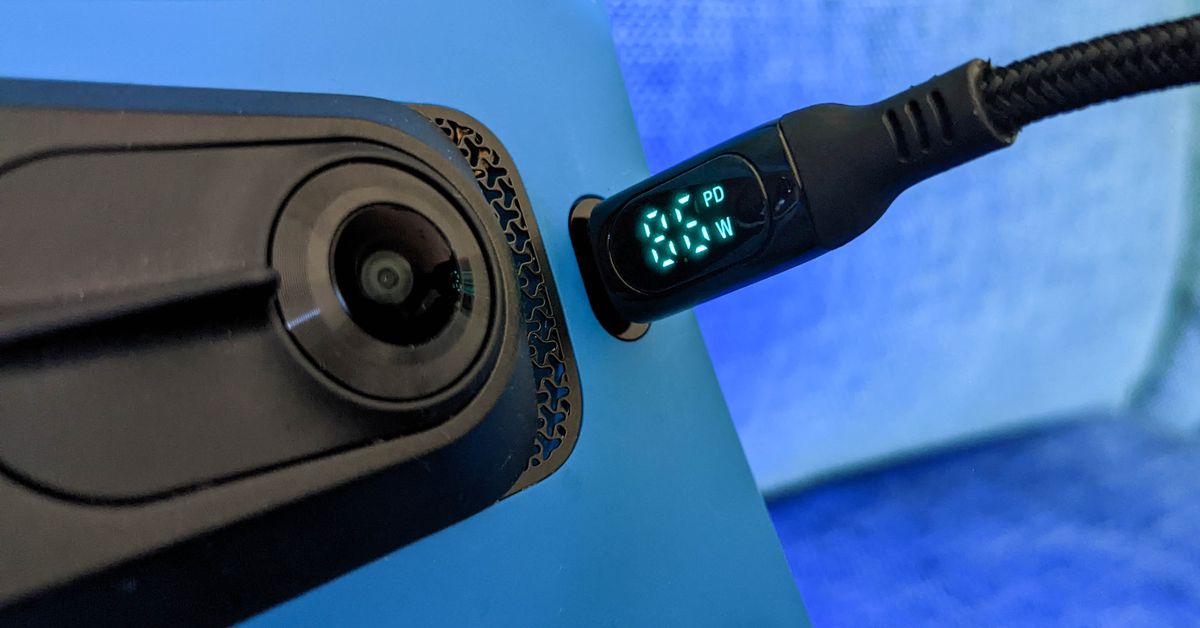You can now buy a 100W USB-C cable with a built-in power meter
While I’m waiting for the adapter that’ll turn my DeWalt power tool batteries into a powerful laptop charger, I thought I might introduce you to another intriguing USB-C trend. You can now buy $20 USB-C cables that come complete with their own wattage meter, letting you see just how fast they’re charging your devices.
I bought mine a month ago — it took its sweet time getting here — but so far, I’m impressed! For the past couple of days, I’ve been plugging it into everything to see how much it draws: 18W for my V2 Nintendo Switch, 30-31W for my DJI Mini 2 drone, 2.5-3W for one of my PS5’s DualSense controllers, 54-65W for my XPS 15, all the way up to 99W for a 14-inch M1 MacBook Pro or a Skydio 2 drone. Or, down to 0.5W while trickle-charging the Wyze Buds Pro.
:no_upscale()/cdn.vox-cdn.com/uploads/chorus_asset/file/23202870/sean_hollister_20220128_144932.jpg)
On Amazon, the cables are largely sold by an alphabet-soup collection of brands like “WOTOBEUS,” “URVNS” and “CHIPOFY”, but the one I bought feels surprisingly high-quality despite that. The tiny teal screen and shiny reversible connectors are set in a metal head, connected to to a decent-quality braided cable with what feels like a reasonable amount of strain relief — though I haven’t tested its “35,000+ bend lifespan” quite yet.
What I did test is its ability to measure power, plugging it into literally every USB-C device my family owns, including an array of chargers. Using a Kill-A-Watt and a separate, detachable USB-C power meter as the baseline, I checked both its accuracy and whether it could charge my devices properly, compared to other cables.
:no_upscale()/cdn.vox-cdn.com/uploads/chorus_asset/file/23202869/sean_hollister_20220128_145336.jpg)
In most cases, it was right on the money, with a few important caveats:
- It only shows watts, not volts and amps. It’s a handy shortcut, but you can learn more from standalone USB-C testers that cost as little as $11 or $17 now.
- You’ve gotta plug the screen end into the thing you’re charging if you want a measurement. It’ll still charge the other way, but the meter isn’t bidirectional.
- For some reason, a few combinations of cable and charger had wacky results: the 14-inch MacBook Pro wouldn’t charge at all from my 100W HyperJuice USB-C battery pack when using this cable, even though it charged just fine if I swapped out the battery for an adapter or this cable for a different cable.
- The DJI Mini 2 also wouldn’t charge at full speed with this cable and one of my four USB-C adapters, even though it worked fine with the other three adapters and my 100W battery.
- My cheapo USB-C to Lightning adapter didn’t work with this cable, so I wasn’t able to test it with an iPhone. But I had no such trouble with one of the standalone USB-C testers and an official Apple USB-C to Lightning charge cable.
The biggest caveat, though, is that this is NOT a high-speed data cable; it’s only suitable for high-speed charging. The transfer rate tops out at the old USB 2.0 speed of 480 Mbps, a far cry from the 5Gbps or 10Gbps you can get with USB 3.1. With a good short SuperSpeed cable, I was able to transfer a 5GB file to my PC from an external SSD in just 17 seconds. This charge cable took a full two minutes longer (2:17) to complete the same task, bottlenecked to just 40MB / second.
That seems to be a limitation of these early cables, unfortunately, as all of them advertise that low speed — even this new bidirectional j5create one that adds some other handy features onscreen. Meanwhile, the standalone USB-C power meter I bought several years ago lets me transfer data at full speed without issues.
None of that’s quite enough to sour me on this cable, because I didn’t have a nice, long charge cable capable of both USB 3 data rates and 100W charging to begin with, and I appreciate not needing to keep track of a meter dongle anymore. I’m fine just using it for charging and pairing a different cable with my SSD. But if you’re truly a USB-C PD connoisseur, I’d probably suggest you pick a standalone meter instead.
For all the latest Technology News Click Here

